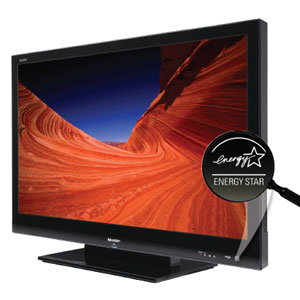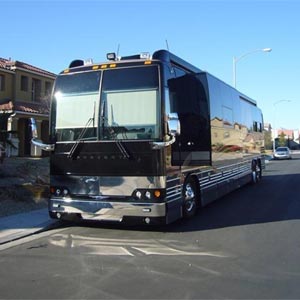
How to Make Energy Savings Sexy
 Standby mode, component selection, automation and power conditioning can be touted as energy-savers. Standby mode, component selection, automation and power conditioning can be touted as energy-savers.
12.09.2009 — Consumer interest in residential energy conservation has been on the rise since Energy Star-qualified desktop PCs and monitors became available over 15 years ago.
Consumers are well aware of the Energy Star logo when seeking out a new major appliance, heating or air conditioning system, flat-panel LCD TV, or just replacing their light bulbs. Newly built homes can also receive the Energy Star qualification if they meet specific criteria.
But apart from flat-panel TVs, consumers may not be fully aware of the opportunities for energy conservation in audio/video systems for a home theater and audio/video distribution. Receivers, amplifiers and DVD players can be major sources of energy consumption when powered continuously without adequate management.
As a result, an A/V system has the potential to consume as much energy, or even more, than major household appliances.
It’s up to CE pros to:
1.Make consumers aware of the energy consumption options
2.Sell them on energy-saving systems
A/V Energy Consumption
In simple A/V installations for homes with a single home theater system, it is likely that the consumer will actively turn on and off all components as the system is being used. However, in larger homes with multiple systems and multiroom A/V, it’s more likely that equipment will be unattended and left powered on indefinitely.
Such equipment is likely to be hidden away in cabinets, equipment closets and other locations where everyday user access is unlikely.
In addition to consuming more energy when left continuously powered, components (especially amplifiers and receivers) radiate heat. In cabinets and racks, fans are then required to prevent overheating, further contributing to energy costs. Additionally, supplemental air conditioning may be necessary to maintain room temperature.
The potential energy consumption can be estimated for audio amplification in a typical whole-house system. In the case of a four bedroom home with six A/V zones with each zone powered with two channels at 70 watts each, the total amplification required would be 840 watts which could be covered by a 12-channel power amplifier.
Lets assume that this amplifier consumes 35 watts when running idle, and is powered 24/7. Under these conditions, even before a single watt is converted to the outputs, this amplifier would consume during 300 kWh (kilowatt-hour) during one year. This is close to the estimated energy requirement for running a dishwasher over the same period, based on Energy Star guidelines for annual household usage.
Other energy-consuming products that may also be used in the system, including TVs and DVD players, will further increase energy costs.
The simple solution to lowering power consumption of amplifiers, receivers, DVD players, and other components in an A/V system is to manage their usage. This can be accomplished by selecting products, especially those that are Energy Star certified, that feature a standby mode whereby energy usage is greatly minimized.
Energy efficiency can also be improved by setting up control systems to power off devices when not in use.
An important aspect of an audio device or DVD player in conserving power usage is the ability to engage a standby mode. When a product is in standby, it is essentially assumed to be “off” with normal functions disabled, but is still minimally powered. One advantage of a standby mode is that the device consumes little power when not actively being used, yet remains in a state whereby user activation through handheld IR or home automation control is still possible.
Most DVD players, amplifiers, receivers, surround sound preamps and processors, and other audio products include a standby mode. However, the amount of power consumed by such devices while in standby can vary. Some products may draw less than 1 watt in standby, while others may draw several watts.
One way to help ensure that a devices standby power is minimal is to select products that are Energy Star qualified. A requirement is that the product offers a standby-mode power draw no greater than 1 watt. This is similar to the Energy Star program for televisions (though the program has since evolved to include power draw specifications during normal operation).
The ability to engage a standby mode is also important in reducing energy for an amplifier. Another is the efficiency of the amplifier during normal operation or when running idle. Traditional Class AB amplifiers are the most common, but are also known for dissipating significant amounts of heat, thus requiring adequate ventilation and possibly cooling in racks and cabinets.
Class D amplifiers convert a far greater proportion of the incoming power into their outputs, and can therefore be much more efficient with substantially less heat dissipation and reduced power consumption requirements.
When selecting an amplifier for its energy efficiency, look for low power consumption and thermal dissipation specifications. Ideally, these specs should be provided for standby, idle, and typical operation or the more accurate 1/8 power.
An efficient amplifier not only contributes to lower energy costs, but also runs at a lower operating temperature. This helps to maintain the reliability and life of the amplifier, as well as other products situated near it in a rack or cabinet.
Automating, Managing Energy
In setting up home automation systems for clients, CE pros can create master controls that allow the client to turn on and off multiple devices at once. Separate controls can be created depending on the specific function, whether listening to music throughout the house, watching TV in multiple rooms, or using the home theater.
With these controls, the owner can easily manage system usage with a touch of a button, from anywhere in the house, without having to directly access products that may be hidden away in a cabinet or rack.
In addition to active system control, CE pros can also set the components in the A/V system to be automatically powered on at a specific time during the day, and then shut off for the night. To further realize energy savings, separate schedules could be employed for the work week and the weekends.
Another way to manage energy consumption through automation systems is to set them up to monitor activity. If no user interaction, motion detection, or A/V signal activity is detected over a predefined period, one hour for example, then the devices would be powered off by the control system.
Power management is an effective approach to improving energy efficiency for A/V systems. Reducing power consumption can be achieved by ensuring that audio products and DVD players have a standby mode to ensure minimal energy consumption when not being used, and by actively or automatically managing their usage with key home automation features.
Because audio devices and DVD players can be a significant draw on energy in the home, the energy savings through effective power management can also be significant. It’s comparable to removing a major appliance, such as a dishwasher or clothes dryer. Effectively managing power usage for A/V systems leads to energy cost savings, reduced environmental impact, and enhanced product reliability.
By Casey Hall
http://www.cepro.com/article/how_to_make_energy_savings_sexy/K332/D1/
Custom Installation Services, LLC – Home Entertainment Audio and Video services in North Carolina.
Posted in Automation
|
Tagged A/V installations, A/V signal, a/v systems, audio advice, Best Buy, Blu-ray, cabinet, ce pro, Charlotte, Class AB amplifiers, Class D amplifiers, control system, cooling, dvd players, energy conservation, energy savings, energy star, Energy Star qualified, equipment closet, fans, flat panel installation, hai, hidden away, Home Automation, home automation control, home automation features, home automation systems, Home Theater, improving energy efficiency, innovative systems, installers, ir, LCD TV, LED TV, Lg, lighting control, lower energy costs, manage energy, Managing Energy, master controls, Media Rooms, motion detection, multiroom a/v, multiroom audio, NC, new homes, Onkyo, power management, rack mount, receivers, reduced environmental impact, RF, s3-av, Samsung, Sharp, Sony, surround sound, whole house system
|
Inside BB King’s $1.4 Million Tour Bus
 For legendary blues guitarist BB King, the thrill isn’t gone when it comes to touring. The 83-year-old “King of the Blues” is still on the road with his famous Gibson guitar “Lucille” performing 100 concerts per year. For legendary blues guitarist BB King, the thrill isn’t gone when it comes to touring. The 83-year-old “King of the Blues” is still on the road with his famous Gibson guitar “Lucille” performing 100 concerts per year.
And King gets from gig to gig on more than just a simple set of wheels.
King rides in a $1.4 million, 45–foot luxury motorcoach that has more than $200,000 worth of electronics inside, making it a center of inspiration for laying down tracks, reviewing audio and video, keeping up to date on news and communicating with his fans and crew. But, most importantly, he’s entertained by a first-class A/V setup.
The interior design of the Prevost XL motorcoach was done by Superior Coach Interiors in Nashville, Tenn., while the electronics were installed by Digital Home Lifestyles of Phoenix, Ariz.
The tour bus, which took 100 hours of design time and 300 hours of installation time to complete, has seven miles of of cabling from Liberty Cable, five miles of Cat5 wiring and 3,000 feet of CresNET. The pre-wiring was done before the walls on the tour bus went up, requiring large bulks of wiring in channels and luggage bays that run the length of the vehicle.
King has a music and video server system that allows him to access a collection of more than 20,000 CDs, 6,000 DVDs and “more VHS tapes than I have ever seen,” according to Daniel Henderson of Digital Home Lifestyles.
Electronics Galore
The electronics on the bus would make any electronics lover blush. There’s a distributed audio/video system with eight zones of video and nine zones of audio. The front and rear lounges have 7.1 surround sound systems that are fed through a combination of dedicated and distributed sources. The sources include:
* 4 DirecTV HR21-PRO DVRs (1 dedicated to the rear lounge, 3 for distributing audio and video)
* 4 Kaleidescape 1080p players (1 dedicated to the rear lounge, 3 for distributed A/V)
* 1 Kaleidescape 3U server
* 1 Crestron iPod dock that is distributed throughout the coach
* 4 individual iPod docks for each bunk
* 1 Crestron XM tuner (distributed to all zones with feedback on all the touchpanels
* 1 AM/FM radio (distributed with feedback on all the touchpanels)
* 2 Integra Blu-ray DVD players (1 dedicated to the rear lounge and 1 dedicated to the front lounge)
* 1 PS3 and 1 Xbox 360 in the front lounge
* 1 Sony Professional DAT Player (dedicated to the rear lounge)
* 1 Aiphone back-up camera (for driver’s touchpanel)
* 1 Aiphone PTZ front door security camera (distributed to all TVs and touchpanels)
The coach has a 12-inch touchpanel in the rear lounge, an 8-inch panel in the front lounge, a 6-inch panel for the driver (also for backup camera) and 4-inch touchpanels in each bunk. There also is a 12-button keypad up front. All controls are hardwired.
Other electronics include:
* 7 Crestron touchpanels
* 8 HDTVs, including two 37-inch LGs with Triad LCR speakers
* 13 Lutron motorized shades
* 6 motorized windows
* A proprietary 12-relay lighting control system designed by Digital Home Lifestyles
* 64 zones of lighting
* Loudspeakers in the luggage bays for music during load-in and load-out
* Temperature sensors
* Surround sound systems with Focal and Triad custom speakers
* 8 headphone jacks that can be used to listen to any source
There are multiple satellite dishes (auto-tracking) to enable eight tuners (four dishes with two tuners each) and occupancy sensors for the bathroom. King also has an emergency button in the lounge in case he needs something.
Power Management
King’s electronics require six separate 20-amp circuits and are powered in three different ways: 1)They can be plugged in when the vehicle is stopped; 2)They can run off the engine’s inverters; 3)They can run off a generator.
That constant switching can wreak havoc on the electronics without proper power management. To solve it, the integrator developed some proprietary logic for the Crestron APS unit for switchover sequencing of the power.
The system remotely communicates with Digital Home Lifestyles to let the company know about failures. King can even press a button on the touchpanels to send an email requesting a service call.
BB Loves Technology
BB King is a content hoarder and techie who always wants the latest gadgets, music and movies. Before he had the Kaleidescape servers, he had a tiny table that was cluttered with five portable hard drives and a laptop plugged into a CD recorder.
Henderson says King had 200 movies on the Kaleidescape servers and 100 TV shows recorded on Tivo within the first month of owning the tour bus.
“The coach is his (and the crew’s) home away from home,” Henderson says. “They don’t sleep in the coach, they stay in hotels every night, but they spend a significant amount of time in there.”
Click here to look Inside BB King’s $1.4 Million Tour Bus.
by Jason Knott
http://www.electronichouse.com/article/inside_bb_kings_14_million_tour_bus/C117
Custom Installation Services, LLC – Home Entertainment Audio and Video services in North Carolina.
Posted in Automation
|
Tagged 20-amp circuit, 7.1 surround, a/v setup, am/fm, AV Components, back-up camera, Blu-ray, cat5, cds, Cool Homes, cresnet, dat, digital home, Digital Media Servers, directv, dish network, Displays, distributed audio, dual tuner, dvd, dvr, email, focal, freemans, gadgets, generator, gibson, hard drive, harmony, HDTV, headphones, Integra, integrator, iPod, Kaleidescape, keypad, laptop, Lg, liberty cable, lifestyles, lighting control, logic, loudspeakers, lutron, motorized shades, multiroom audio, Multiroom Video, portable, power management, ps3, receivers, rg6, security, Set Top Boxes, sirius, sound systems, superior coach, surround sound, temperature sensors, tivo, triad, vhs, wii, xbox, xm
|
Best Products of 2009
 12.08.2009 — It’s pretty safe to say we’re all glad that 2009 is almost over and we can look ahead with some optimism. 12.08.2009 — It’s pretty safe to say we’re all glad that 2009 is almost over and we can look ahead with some optimism.
Despite the economic woes, 2009 wasn’t a total failure. There were many great products released that ran the gamut from Blu-ray players to projectors, receivers, subwoofers and more.
These products revealed several trends that are expected to grow in 2010, including adoption of Blu-ray, 2.40:1 home systems, migration to two-channel audio and more.
We’ve rounded up the Best Products of 2009 and broken them down by several categories:
* Best Overall Products
* Best Video Products
* Best Audio Products
* Best Blu-ray Player and Movies
* Best Accessories
* Best Video Games
Click here to view the Best Products of 2009
By Robert Archer
http://www.cepro.com/article/best_products_of_2009/
Custom Installation Services, LLC – Home Entertainment Audio and Video services in North Carolina.
Posted in Audio Systems, Automation, Blu-ray, Flat Panel TV's, lighting control
|
Tagged 2.40:1, accessories, audio, audio advice, Blu-ray, electronic house, flat panel tv, Home Automation, home builders, home specialties, home systems, i-phone, i-pod, indian trail nc, innovative systems, Marantz, martin logan, Media Rooms, nano, new construction, new homes, projectors, receivers, retrofit, s3-av, snap av, Speakercraft, speakers, subwoofers, trends, TV Mounts, two-channel, wii, x-box, zobo
|
|
|
|
 Standby mode, component selection, automation and power conditioning can be touted as energy-savers.
Standby mode, component selection, automation and power conditioning can be touted as energy-savers.


 For legendary blues guitarist BB King, the thrill isn’t gone when it comes to touring. The 83-year-old “King of the Blues” is still on the road with his famous Gibson guitar “Lucille” performing 100 concerts per year.
For legendary blues guitarist BB King, the thrill isn’t gone when it comes to touring. The 83-year-old “King of the Blues” is still on the road with his famous Gibson guitar “Lucille” performing 100 concerts per year. 12.08.2009 — It’s pretty safe to say we’re all glad that 2009 is almost over and we can look ahead with some optimism.
12.08.2009 — It’s pretty safe to say we’re all glad that 2009 is almost over and we can look ahead with some optimism.